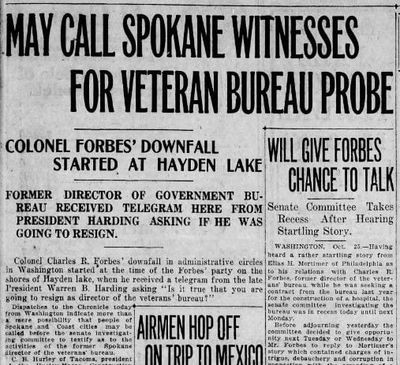100 years ago in the Inland Northwest: Hayden Lake was the setting for a federal official’s potential downfall

A huge national scandal involving liquor “orgies” and the Veterans Bureau had a local angle.
Former Veteran’s Bureau director Charles B. Forbes, who lived in Spokane before his appointment, was charged with taking bribes during wild booze parties.
One of those parties took place at Hayden Lake in North Idaho while Forbes was visiting. Reports differed over whether liquor was flowing at that party. Yet one semi-scandalous detail emerged.
“While fishing from a dock, Colonel Forbes ‘dared’ the divorced wife of a prominent Spokane businessman to jump in the lake with her early morning gingham dress on,” according to a confirmed report. “… Forbes, fully dressed, was the hero as he jumped in after her.”
Even “fully dressed,” this seemed risqué for the era.
In fact, the Chronicle wrote, “Forbes’ downfall started at Hayden Lake.” That night, President Warren G. Harding sent him a telegram asking, “Is it true that you are going to resign as director of the Veteran’s Bureau?”
This party, and other parties in other cities, came to light during a Senate investigation. Now, it appeared that participants in the Hayden Lake party, would be called to Washington DC to testify.
From the highway beat: Spokane stood to gain from the state’s next major road project, a paved east-west highway across the state.
The state highway department said it intended to connect the newly paved north-south route, the Pacific Highway, with a route that would cross the Cascades and go through Spokane. It would include portions of the already existing Sunset Highway and Inland Empire Highway.
“There can be no doubt that the next step proposed is one which this city earnestly desires,” opined the Spokane Daily Chronicle’s editorial page.
The editors cautioned that it would take at least two years, because “work on the passes must be done first, and many other improvements of grades and curves are recommended before paving is attempted.”